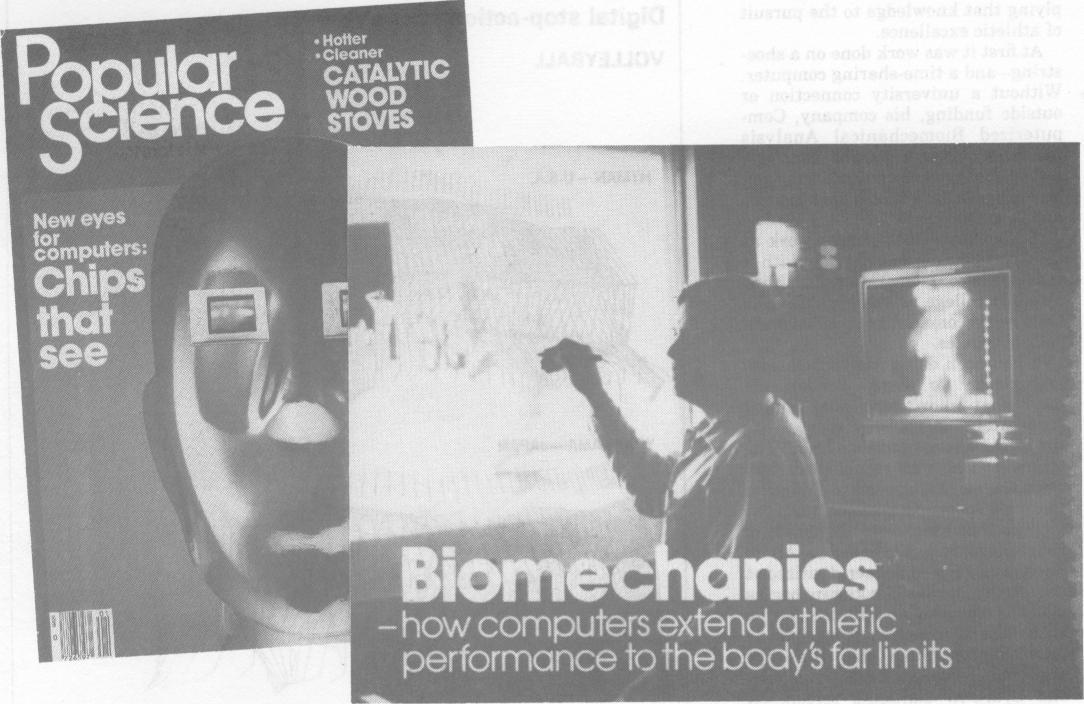| Index | Next |
![]()
By DANIEL RUBY
TRABUCO CANYON, CALIF.
"Explode."
The heavyset man yelled in my ear as I strained to jolt the bar upward. But it was much heavier near the top of its travel than it had been at first. I lost momentum.
"Try again," he said disapprovingly. But my second bench press-and third-proved just as feeble.
A color graph appeared on the screen, displaying a shortage of footpounds where I'd need them most for heaving an iron ball. "You'll never make it as a shot-putter, my friend," said Gideon Ariel, a one-time Olympic shot-putter himself and inventor of the computerized weight machine that had just defeated me.
Ariel's exercise machine, which is programmed to offer variable resistance to match the physical demands of the sport being trained for, is just one of the electronic devices he uses at the Coto Research Center to quantify the forces and stresses generated in athletics. Sophisticated computers,
digitizing pens and hardware, highspeed cameras, force plates, and infrared detectors are the instruments that turn an already first-class sports complex (tennis courts, running track, gym, swimming pools, equestrian grounds) into the world's premier laboratory for the study of biomechanics-the science that relates the physics of motion to human anatomy.
The basis for Ariel's work is that old con man's truth: The hand is quicker than the eye. So are the feet, head, and every other part of an athlete's body. Only by slowing down the motion on film or videotape can anyone really tell what happens when a racket hits a ball or a foot meets a track.
Thigh bone's connected ...
Of course, the use of film alone is nothing new to sport. What is newand is becoming a powerful tool in recognizing talent, training athletes, treating their injuries, and designing their equipment-is the use of computer technology to quantify the velocities, accelerations, and angles generated in athletic performance.
"It's basic physics," Ariel said, using as an example his work with four-time Olympic discus champion Al Oerter. "We know that for the discus to go so far it must leave the hand at a certain
MELODY BRADEN
velocity and a certain angle. So we work backward. For the discus to have that velocity, then the hand must have that velocity. For that to happen, the forearm must be moving so, then the upper arm, the torso, and so on down to the feet. We created a computer model of the optimum throw and then tried to teach the athlete to do that."
At age 43, after working with Ariel, Oerter threw 27 feet farther than his best gold-medal performance. Now he is training for a comeback at the 1984 Olympics.
The interdependence of body parts is true of all sports. Ariel's coresearcher at Coto, psychologist and tennis guru Vic Braden, uses the analogy of a whip. "Power supply comes from efficiently transferring shock from one body segment to another and finally into the implement or ball." Or as Ariel likes to say: "You can't shoot a cannon from a canoe."
Ariel himself once shot cannons-or tried to. Competing for his native Israel in the 1960 and '64 Olympics, his best shot puts landed far short of the gold. But if he lacked natural ability with 16-pound shots, he had it to spare for work with computers. He came to the U.S. and received his doctorate in computer science, then set about ap
POPULAR SCIENCE January 1982

![]()
| Index | Next |